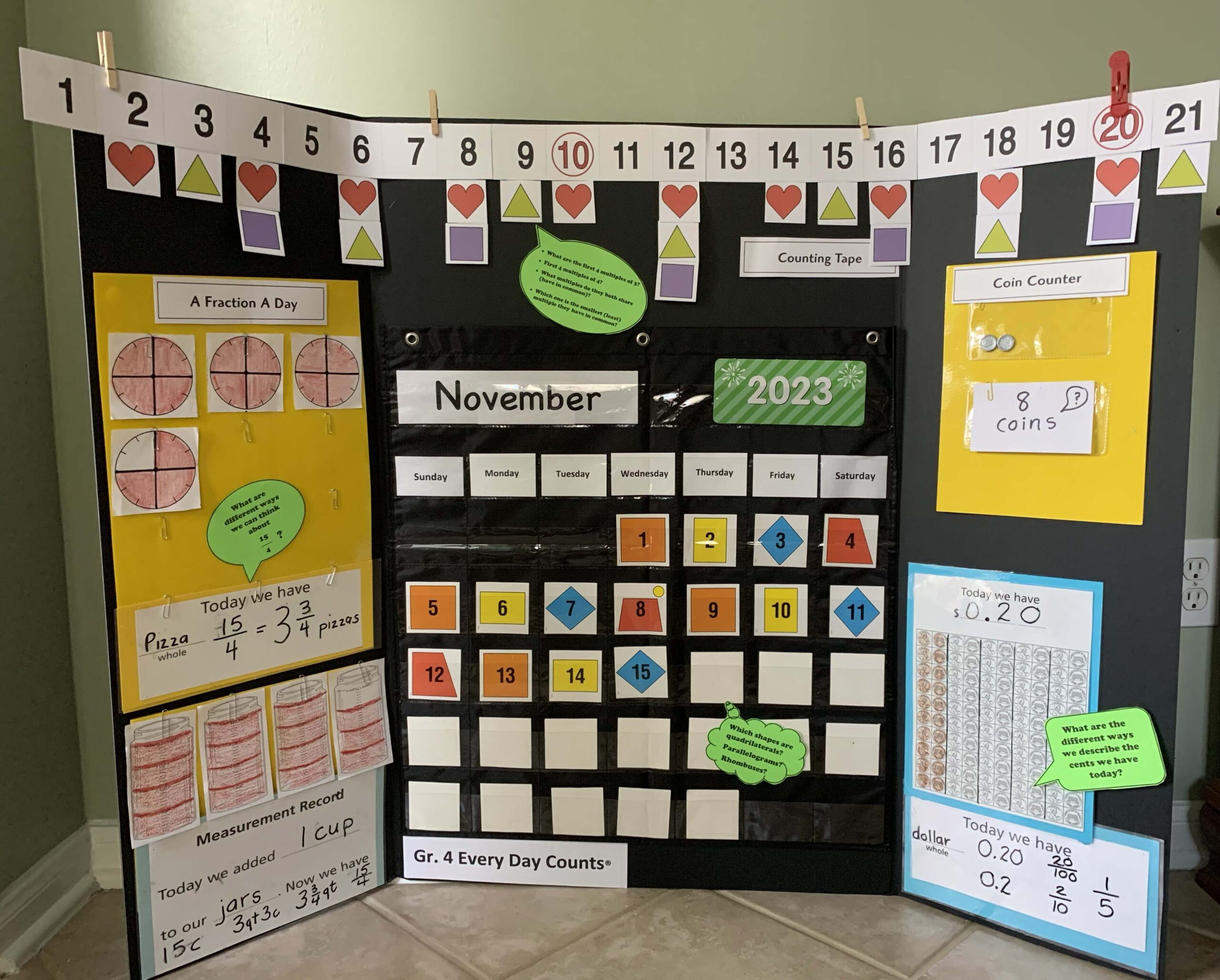FAQ’s

Every Day Counts Calendar Math, K-5, provides “math to see and talk about” in 10-15 minute daily discussions that build concepts and math language critical to student success with any common core math program.
Students engage daily with a Calendar displaying different pattern pieces each month, a Counting Tape with Day of School markers, and 3 to 5 other elements such as the Clock, Coin Counter, Daily Depositor, Measurement, Computations and Connections, Number Builder, Graph, Fraction a Day, and Daily Decimal, depending on grade level.
Every Day Counts helps students see patterns in mathematics, develop algebraic thinking, increase computational fluency, and build consistent math language from grade to grade, providing a way for schools to boost achievement school-wide.
Intro to Every Day Counts Handouts:
- The intent of Every Day Counts Calendar Math used as a supplementary program: Intent of EDC
Every Day Counts Teacher Guide Layout: Understanding EDC Elements - Every Day Counts Calendar Math content by grade level. A one page breakdown of the K-6 content of Every Day Counts: EDC Grade Level Content
- Grade Level Team EDC Planning Agendas:
A QUICK Every Day Counts Grade Level Team Prep Session for monthly use: EDC Quick Team Prep Agenda - A 2 HOUR Every Day Counts Grade Level Team Reflection, Planning, and Prep Session for monthly use: EDC 2hr Team Planning Agenda
Conference Session Handouts by Jan Gillespie:
- Gillespie X Fact Fluency Session at NWMC 2022: Handout
- X Array Flash Cards & Assessment Masters: Handout
- X Fact of the Week Posters: Handout
- A handout from Jan Gillespie’s session for principals at the ASCD conference in Orlando, Florida, March 14th, 2009: ASCD Session Handout 1
ASCD Session Handout 2
*What does EDC look like from K to grade 5?
Every Day Counts closely reflects the content of the Common Core Standards in all strands in grades K-3. At grades 4-5 specific critical grade level CCSM topics such as number theory, fractions, decimals, place value, hierarchy of geometric shapes, measurement and functions are represented with different EDC elements each month.
*How can EDC discussions promote CCSM Practices?
The instructional methodology creates daily opportunity to pose questions and invite student observations that encourage sense-making, reasoning, meta-cognition, and communication for all your students, in the spirit of CCSM Practices.
*How do I keep EDC to only 10-15 minutes a day?
Many teachers ask how to keep EDC discussions to 10-15 minutes? The secret is to update the elements on the bulletin board each day but to focus the discussion on only one or two elements each day.
Calendar discussions and elements that reflect the Calendar date are a nice fit for Monday, since we need to catch up after the weekend, and on Fridays at the end of the week when more patterns have been revealed.
The Counting Tape and elements that reflect that number can be the focus on Tuesday and Wednesday, leaving Wednesday for catching up Graphs and revisiting an element or two that you wish to give extra attention to that week.
Another strategy for limiting EDC to 10-15 minutes is to back it up against a set time when the class must move on (e.g. lunch time, a special class, or reading block, etc.) Remind the children there will be many more opportunities to share what they see on future days.
*How can I make the best use of my EDC Teacher Edition?
The content in the EDC Teacher Edition is organized by elements in the same way every month to help you find information you need to prepare the materials for the board and to help you develop a rich repertoire of question to encourage children in their reasoning, thinking, and sharing of strategies. Each month you will find the Calendar first, followed by elements that make use of the Calendar Date. Then you will find the Counting Tape, followed by elements that make use of the Days in School. Elements that reflect neither the date or day of school are last each month.
Note that the Daily Routine includes procedures and language to emphasize during the changing of the data each day, but that Discussion is where you’ll find examples of questions to encourage lots of discourse and examination of mathematical patterns and relationships.
*How do I get started setting up EDC in my classroom?
Click on ‘Getting Started – EDC Set Up’ under our Samples here at edconline.net, follow the suggested steps, and you will be able to locate what you need from the EDC Kit for the first month of school.
*How is Every Day Counts used in a year-round school?
Most year-round teachers have taken the approach of thinking of September as Month 1, and October as Month 2, and so on, adapting Every Day Counts, month by month, to their particular year-round track or school year calendar. That said, here’s a bit more of an explanation:
The Counting Tape and its companion elements from Every Day Count’s September will always reflect the number of Days of School that that class of students have come to school.
The Calendar will show the current month label and I would recommend using the August Calendar Pieces for June, July, or August, regardless of the month in which you begin teaching. The September pieces can be saved to use in the first full month where students will be in class during the first days of a month. The elements in Every Day Counts for September that reflect the days of the month from 1 to 30 can be introduced in this same first full month. Then the next month you can progress to October and so on, month by month.
When your 2 to 4 week breaks occur, you will need to decide upon your return whether it would be best to reuse and repeat the month’s elements that you were using in the month prior to the break, or whether to introduce Calendar elements shown in Every Day Counts for the next month. By repeating the use of the Calendar pieces and the Calendar elements about twice a year, the nine months of content presented in the September to May Every Day Counts teacher’s guide works well for year-round classes.

